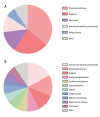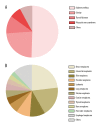Identification of Recent Trends in Research on Vitamin D: A Quantitative and Co-Word Analysis
- PMID: 30668558
- PMCID: PMC6350455
- DOI: 10.12659/MSM.913026
Identification of Recent Trends in Research on Vitamin D: A Quantitative and Co-Word Analysis
Abstract
BACKGROUND In recent years, many studies on vitamin D have been published. We combed these data for hot spot analyses and predicted future research topic trends. MATERIAL AND METHODS Articles (4625) concerning vitamin D published in the past 3 years were selected as a study sample. Bibliographic Items Co-occurrence Matrix Builder (BICOMB) software was used to screen high-frequency Medical Subject Headings (MeSH) terms and construct a MeSH terms-source article matrix and MeSH terms co-occurrence matrix. Then, Graphical Clustering Toolkit (gCLUTO) software was employed to analyze the matrix by double-clustering and visual analysis to detect the trends on the subject. RESULTS Ninety high-frequency major MeSH terms were obtained from 4625 articles and divided into 5 clusters, and we generated a visualized matrix and a mountain map. Strategic coordinates were established by the co-occurrence matrix of the MeSH terms based on the above classification, and the 5 clusters described above were further divided into 7 topics. We classified the vitamin D-related diseases into 12 categories and analyzed their distribution. CONCLUSIONS The analysis of strategic coordinates revealed that the epidemiological study of vitamin D deficiency and vitamin D-related diseases is a hot research topic. The use of vitamin D in the prevention and treatment of some diseases, especially diabetes, was found to have a significant potential future research value.
Conflict of interest statement
None.
Figures






Similar articles
-
Bibliometric Analysis of Tumor Immunotherapy Studies.Med Sci Monit. 2018 May 23;24:3405-3414. doi: 10.12659/MSM.910724. Med Sci Monit. 2018. PMID: 29790485 Free PMC article.
-
Bibliometric and Visual Analysis of the Research Status and Knowledge Structure of Assisted Reproductive Therapy for Patients with Premature Ovarian Insufficiency.Altern Ther Health Med. 2024 Jan;30(1):102-110. Altern Ther Health Med. 2024. PMID: 37773652
-
A bibliometric analysis of publications on venous thromboembolism in children from 1988 to 2019.Medicine (Baltimore). 2020 May;99(20):e20114. doi: 10.1097/MD.0000000000020114. Medicine (Baltimore). 2020. PMID: 32443321 Free PMC article.
-
Mapping the knowledge structure and trends of epilepsy genetics over the past decade: A co-word analysis based on medical subject headings terms.Medicine (Baltimore). 2019 Aug;98(32):e16782. doi: 10.1097/MD.0000000000016782. Medicine (Baltimore). 2019. PMID: 31393404 Free PMC article.
-
Mapping Research Trends of Medications for Multidrug-Resistant Pulmonary Tuberculosis Based on the Co-Occurrence of Specific Semantic Types in the MeSH Tree: A Bibliometric and Visualization-Based Analysis of PubMed Literature (1966-2020).Drug Des Devel Ther. 2023 Jul 10;17:2035-2049. doi: 10.2147/DDDT.S409604. eCollection 2023. Drug Des Devel Ther. 2023. PMID: 37457889 Free PMC article. Review.
Cited by
-
China's changing expectations of the SCO between 2001 and 2019.PLoS One. 2023 Mar 9;18(3):e0275625. doi: 10.1371/journal.pone.0275625. eCollection 2023. PLoS One. 2023. PMID: 36893159 Free PMC article.
-
Viroinformatics-Based Analysis of SARS-CoV-2 Core Proteins for Potential Therapeutic Targets.Antibodies (Basel). 2021 Jan 11;10(1):3. doi: 10.3390/antib10010003. Antibodies (Basel). 2021. PMID: 33440681 Free PMC article.
-
Does de-implementation of low-value care impact the patient-clinician relationship? A mixed methods study.BMC Health Serv Res. 2022 Jan 6;22(1):37. doi: 10.1186/s12913-021-07345-9. BMC Health Serv Res. 2022. PMID: 34991573 Free PMC article.
-
Global trends in research on extracorporeal shock wave therapy (ESWT) from 2000 to 2021.BMC Musculoskelet Disord. 2023 Apr 20;24(1):312. doi: 10.1186/s12891-023-06407-9. BMC Musculoskelet Disord. 2023. PMID: 37081473 Free PMC article.
-
Mapping intellectual structures and research hotspots in the application of artificial intelligence in cancer: A bibliometric analysis.Front Oncol. 2022 Sep 22;12:955668. doi: 10.3389/fonc.2022.955668. eCollection 2022. Front Oncol. 2022. PMID: 36212413 Free PMC article.
References
-
- Pereira-Santos M, Costa PR, Assis AM, et al. Obesity and vitamin D deficiency: A systematic review and meta-analysis. Obes Rev. 2015;16:341–49. - PubMed
-
- Afzal S, Brondum-Jacobsen P, Bojesen SE, Nordestgaard BG. Vitamin D concentration, obesity, and risk of diabetes: A mendelian randomisation study. Lancet Diabetes Endocrinol. 2014;2:298–306. - PubMed
Publication types
MeSH terms
Substances
LinkOut - more resources
Full Text Sources
Medical
Miscellaneous

